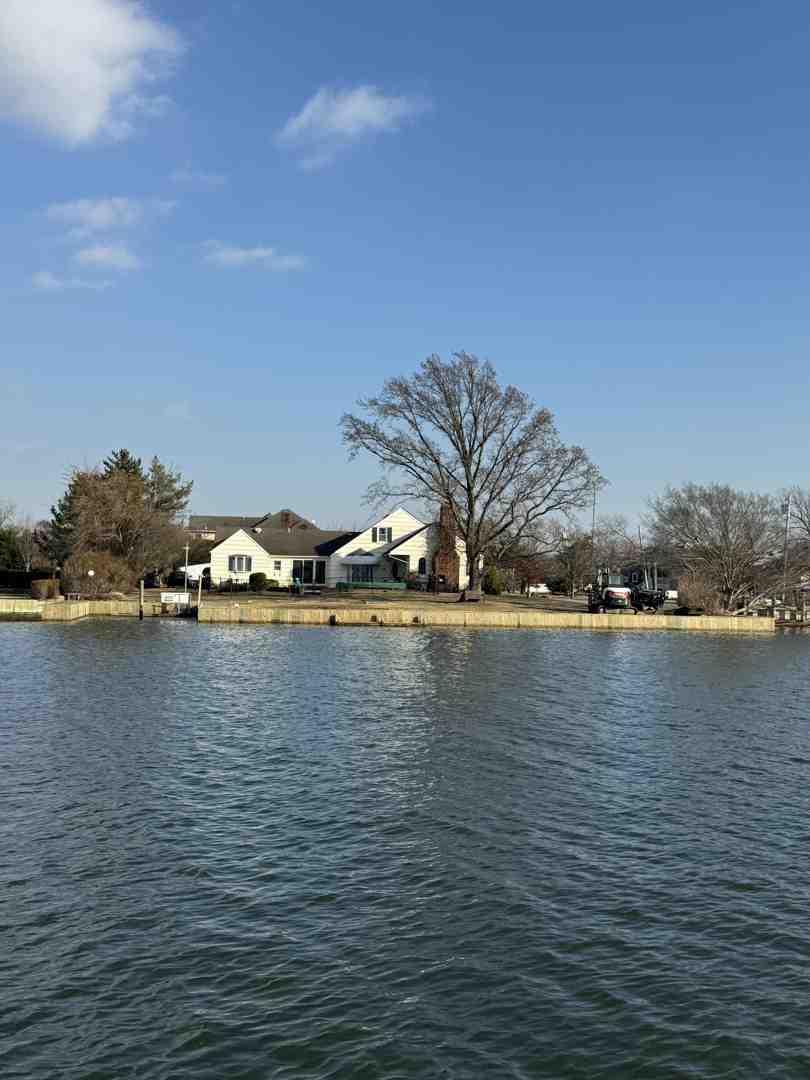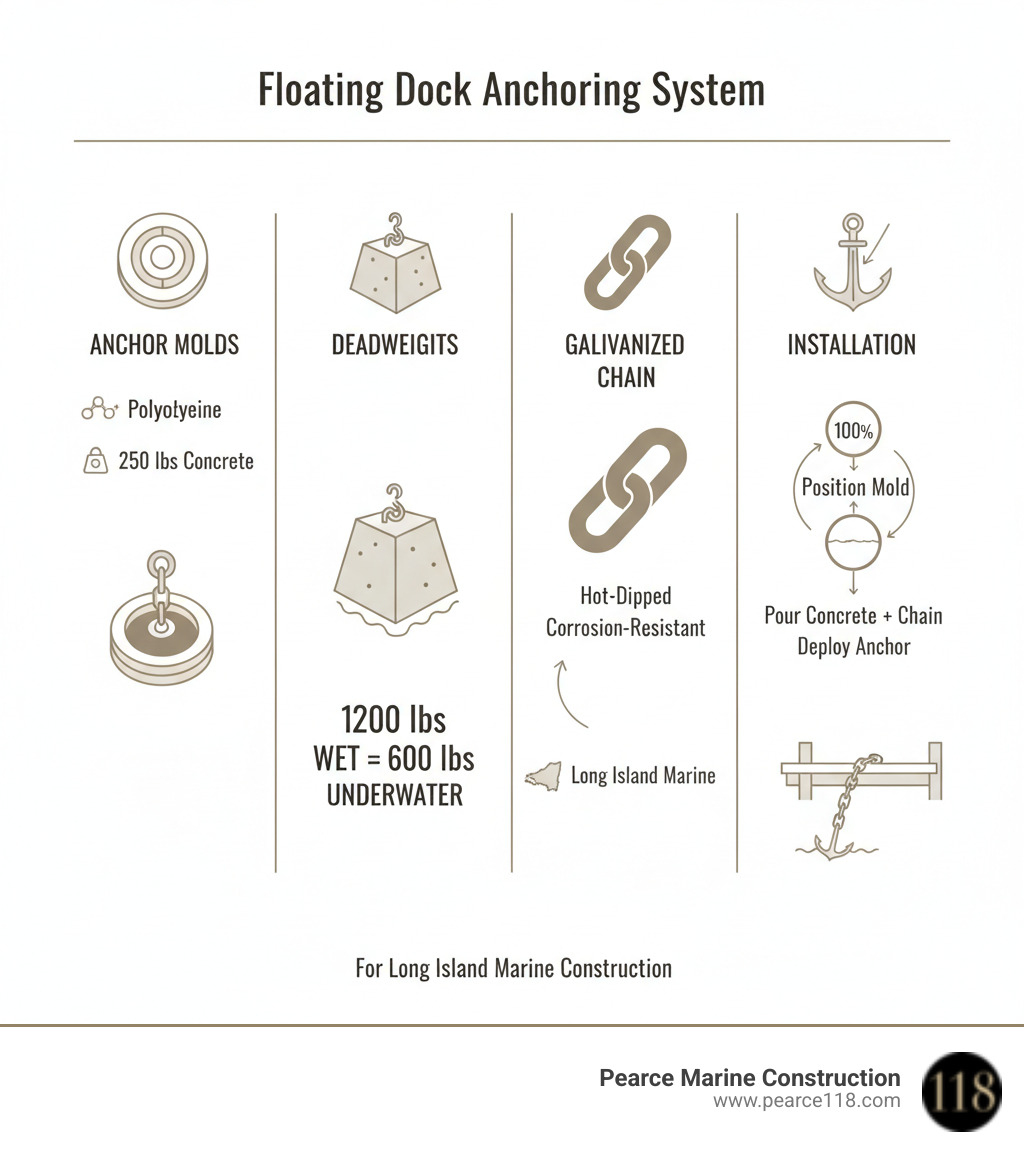Molding Your Dock's Future: A Guide to Anchor Molds

Why Proper Anchoring Matters for Your Waterfront Investment
A floating dock anchor mold is a specialized forming tool used in marine construction to create custom concrete deadweight anchors that secure floating dock systems to the seabed. These molds, typically made from heavy-duty polyethylene or plywood, allow construction crews to cast concrete anchors weighing 150-600+ pounds on-site for optimal dock stability.
Key anchor mold specifications for Long Island installations:
- Standard capacity: 250 lbs of concrete (3 bags of mix)
- Common dimensions: 24" diameter x 10" high for round molds
- Material: Marine-grade polyethylene or plywood forming kits
- Features: Central chain hole, integrated handgrips for safe handling
- Professional use: Creates multiple anchors per project for complete dock systems
Your floating dock represents a significant waterfront investment - one that needs proper anchoring to withstand Long Island's nor'easters, tidal changes, and seasonal storms. Without adequate deadweight anchoring, even the most beautiful dock can become "Atlantic Ocean drift wood" after severe weather.
The stakes are high. Concrete loses about half its weight underwater due to buoyancy, meaning a 600-pound underwater anchor requires approximately 1,200 pounds of concrete above water. Professional marine construction crews use anchor molds to create these heavy, precisely-weighted deadweight systems that protect your dock and neighboring properties.
At Pearce Marine Construction, we've seen how proper anchoring systems prevent costly damage and insurance claims. Our approach focuses on engineered solutions that account for Long Island's unique shoreline conditions - from the protected bays of Nassau County to the more exposed waters of Suffolk County.

Floating dock anchor mold terms to remember:
What is a Floating Dock Anchor Mold?
Think of a floating dock anchor mold as a specialized concrete form designed for one crucial job: creating the heavy deadweight anchors that keep your floating dock exactly where it belongs. These aren't just any molds – they're engineered specifically for marine construction, with features that make casting reliable concrete anchors straightforward and consistent.
When we're installing a new floating dock system along Long Island's shoreline, these molds become essential tools in our construction process. They allow us to create custom-cast deadweight anchors right on-site, ensuring each anchor meets the exact specifications your dock system requires. Whether we're working in the calm waters of a Nassau County bay or the more challenging conditions of Suffolk County's exposed shorelines, having the right anchor weight is non-negotiable.
The beauty of using these specialized molds lies in their purpose-built design for marine construction. Every detail – from the central chain hole to the smooth release surfaces – has been thought through by engineers who understand what it takes to secure floating structures in real-world conditions. This isn't improvised construction; it's precision work that protects your waterfront investment.
At Pearce Marine Construction, we rely on these molds because they deliver consistency. When your dock faces a nor'easter or heavy boat traffic, you want to know that every anchor was cast to the same exacting standards. That's the level of reliability our clients deserve, and it's what proper Floating Dock Anchoring demands.
Anatomy of an Anchor Mold
Quality anchor molds reflect decades of marine industry experience. Polyethylene molds are the gold standard for professional crews, offering durability against repeated pours and the harsh marine environment. These single-piece units resist concrete adhesion, making demolding smooth and extending the mold's life.
Plywood forming kits are another option, useful for creating anchors with specific dimensions. These kits use pre-cut pieces and marine-grade fasteners for precise control over the anchor's shape and size. While less reusable than polyethylene, they are excellent for custom jobs.
Durability and reusability are crucial for construction crews. A quality mold pays for itself over multiple projects by reducing costs and ensuring consistent results. This reliability provides better value and more predictable timelines for our clients.
The central hole for chain or hardware is a critical design feature. This opening allows secure chain attachment without compromising the concrete's integrity, preventing a weak link in the anchoring system.
Integrated handgrips are essential for safety, not just convenience. Moving a 250-pound concrete anchor requires secure grip points. Quality molds include these features, allowing our crews to handle anchors safely and efficiently.
Professional dock construction often uses molds with a 250-pound capacity, balancing holding power with practical handling. These dimensions suit most Long Island floating dock installations, though larger projects may need multiple or custom-sized anchors.
Why Use Molded Concrete Anchors?
On-site casting with a floating dock anchor mold is cost-effective for large projects compared to buying and transporting pre-made anchors. We source concrete locally, eliminate heavy shipping costs, and cast the exact number of anchors needed, which means better pricing for our clients.
Customizable weight allows us to engineer solutions for Long Island's diverse waterfronts. A protected cove may need standard 250-pound anchors, while an exposed bay requires heavier deadweights. This adaptability ensures reliable performance in any environment.
The high holding power of deadweight anchoring comes from sheer mass. Once on the seabed, concrete anchors resist lateral forces, a reliable method that works across Long Island's varied bottom types, from sandy shores to the substrates of Long Island Sound.
The advantages over improvised solutions are significant. Makeshift anchors like old engine blocks inevitably fail. Professional anchor molds ensure every deadweight has proper attachment points, consistent weight, and the structural integrity for long-term marine service. This commitment to engineered solutions reflects our approach to every aspect of dock construction. When you're investing in a floating dock system, the anchoring deserves the same professional attention as the dock itself. That's why our Dock Anchors for a Floating Dock installations focus on proven, reliable construction methods that protect your investment for years to come.
Calculating Weight and Holding Power
Understanding the physics of floating dock anchoring is key to protecting your waterfront investment. We design anchoring systems to withstand unseen forces like sudden wind, boat wakes, and Long Island nor'easters. The buoyancy principle is critical: a concrete anchor loses about half its weight in water. A recommended minimum of 600 pounds of underwater holding power requires casting a 1,200-pound anchor on land.
Sizing for storms means planning for worst-case scenarios. Fetch distance—the open water stretch wind travels—is a key factor in determining wave height and wind load. A protected cove requires less anchoring than an exposed bay.
The folks at FEMA have documented the benefits of proper anchoring, showing that well-anchored floating docks actually protect boats better during hurricanes than their fixed counterparts. That's not just good engineering – that's peace of mind when storm warnings start flashing across your weather app.
Comparing Anchoring Approaches in Marine Construction
Choosing the right anchoring method depends on site conditions, budget, and long-term goals. Our experience across Nassau and Suffolk Counties helps us determine what works best for each location.
| Anchoring Method | Holding Power | Suitability for Bottom Type (Mud, Sand, Rock) | Installation Complexity | Cost |
|---|---|---|---|---|
| Custom-Cast Concrete Block Anchors | Very High (mass-dependent) | Good (all, best on soft/sandy to set) | Moderate (casting, deploying heavy weights) | Moderate (materials, labor for casting) |
| Driven Piles | Extremely High (direct seabed penetration) | Excellent (mud, sand, some rock) | High (specialized pile driving equipment) | High (equipment, materials, permits) |
| Engineered Deadweight Systems | Very High (designed for specific loads) | Good (all, mass-dependent) | Moderate to High (specialized weights, deployment) | Moderate to High (materials, custom fabrication) |
| Helix Anchors | High (screws into seabed) | Excellent (mud, sand, softer clay) | Moderate (specialized helical drive equipment) | Moderate to High (equipment, materials) |
| Mushroom Anchors | Moderate to High (excellent in soft mud) | Excellent (mud, soft bottoms) | Low (can be dropped, then allowed to set) | Low to Moderate (pre-manufactured) |
| Stiff Arm Anchoring | Varies (relies on shore/piling connection) | N/A (connects to fixed points) | Moderate (fabrication, connection to shore/piling) | Moderate (materials, fabrication) |
Custom-cast concrete anchors made with a floating dock anchor mold offer a great balance of holding power, versatility, and cost-effectiveness for most Long Island sites. While driven piles provide maximum security, they are costly and require special equipment. Helix anchors are ideal for soft bottoms, and mushroom anchors excel in mud, where they bury themselves over time. Our recommendation is always based on a thorough site assessment and a discussion of your priorities.
The Importance of a Complete System
An anchor is only as strong as its weakest link. A perfectly cast concrete anchor is useless if connected with undersized chain or cheap hardware, which can lead to failure in severe weather.
Chain size is crucial. We typically start with 3/8" galvanized chain for Long Island waters, using heavier chain for larger docks or exposed locations. Chain length should be 1.5 to 2 times the maximum water depth to provide proper scope and shock absorption.
Don't cut corners on marine-grade hardware. Saltwater causes significant corrosion. We use stainless steel hardware in saltwater environments like the bays around South Hampton and Huntington to prevent failure. Mixing metals, like stainless steel shackles with galvanized chain, can accelerate corrosion.
Layout patterns are the final piece. We typically use an X-configuration at dock corners for multi-directional stability. Longer docks get additional side anchors to prevent swaying. This comprehensive approach to Floating Dock Anchoring Systems creates a reliable, long-lasting marine structure.
The Professional Process for Using a Floating Dock Anchor Mold
Using a floating dock anchor mold is one step in our carefully orchestrated marine construction process at Pearce Marine Construction. It's about precision, safety, and efficiency born from years of waterfront experience, not just mixing concrete. Imagine our crew installing a new floating dock in Huntington Bay. We arrive with multiple molds to create anchors weighing 600 pounds or more, ensuring the dock is secure against Long Island weather. Safety is paramount when handling such heavy weights.
For larger projects, we often cast anchors on a work barge. This allows us to pour multiple anchors at once and let them cure while we continue with other installation tasks, improving efficiency and keeping the project on schedule. Professional equipment is key. We use cranes for positioning heavy anchors and specialized tools for precise placement. This professional preparation distinguishes our Boat Dock Construction from DIY attempts that often fail in storms.
Step 1: Creating the Concrete Anchor
Creating the anchor begins with selecting the right marine-grade concrete mix, which is formulated for constant moisture and temperature changes. A standard 250-pound anchor requires about three 66-pound bags. The right concrete consistency is crucial to avoid weak spots. Our experienced crews know how to achieve the perfect mix for strong, reliable anchors.
Adding rebar for reinforcement provides extra insurance against cracking under stress, making the anchor more resilient during a nor'easter. Curing time of 24 to 48 hours is non-negotiable for proper strength. We protect the concrete during curing to ensure a smooth, durable finish and clean release from the mold. Mold maintenance is essential for longevity. We clean and inspect molds after each use. A well-maintained mold is a valuable asset that can produce hundreds of anchors.
Step 2: Deploying the Anchor
Handling heavy weights safely is a job for professionals. Moving a 600-pound anchor requires proper equipment and experienced crews to prevent injury or damage. For major installations, we use marine construction equipment like crane-equipped barges. This allows for precise anchor positioning according to engineering plans and provides a stable work platform.
Shore-based installation is suitable for smaller anchors. Molds with features like handgrips allow us to move anchors using leverage. A 250-pound anchor can be rolled to the water's edge and positioned using a small boat. Precise positioning is critical. We consider water depth, bottom conditions, and potential forces. An anchor placed just a few feet off its optimal spot can lose significant holding power. Our crews use GPS and depth finders for accuracy.
Step 3: Connecting the System
Once anchors are on the seabed, we begin attaching heavy-duty chain to the central hole. We use properly sized, marine-rated galvanized or stainless steel chain. Galvanized or stainless steel shackles connect the anchor and chain. We recommend stainless steel in Long Island's saltwater to avoid costly corrosion failures. Investing in quality hardware prevents expensive underwater repairs.
Securing to the dock involves engineered connection points like retainers or brackets that distribute loads. These are integrated into the dock's structure, not just bolted on. Adjusting chain slack is crucial for Long Island's tidal ranges. We typically allow 1 to 2 feet of slack to accommodate water level changes while keeping the dock stable. This attention to detail makes our Anchoring a Floating Dock installations reliable. You'll have peace of mind during the next storm knowing every component was professionally installed.
Frequently Asked Questions about Concrete Dock Anchors
In our marine construction work across Long Island, we frequently answer questions about the concrete anchors made with a floating dock anchor mold. Here are some insights based on our experience.
How much anchor weight is needed for a floating dock?
Many DIY attempts go wrong with anchor weight. While 600 pounds of underwater weight per corner is a common recommendation, many don't realize concrete weighs less underwater. The "double the weight" rule is crucial: concrete loses about half its weight when submerged due to buoyancy. A 600-pound underwater anchor requires casting a 1,200-pound block on land.
Sizing isn't just a formula. We consider dock dimensions, as larger surfaces catch more wind and current. Site conditions are also critical; a protected inlet in Huntington Harbor requires less anchoring than a dock exposed to Great South Bay. Local weather patterns like nor'easters guide our calculations. We engineer for worst-case scenarios, not calm days. Each anchor system is calculated for your location's specific challenges.
What are the environmental considerations of concrete anchors?
Environmental stewardship is important in marine construction. When properly deployed, concrete anchors have a relatively small environmental footprint. Once cured, concrete is an inert material that doesn't leach chemicals. Over time, marine life colonizes the surfaces, turning anchors into small artificial reefs that become part of the ecosystem.
Proper deployment is key. Our professional crews are trained to avoid sensitive habitats like eelgrass beds. We select placement locations to maximize holding power while minimizing ecological impact. Compared to other methods, concrete deadweight systems disturb the seabed less than driven piles or helix anchors. The blocks are simply lowered into position, causing minimal disturbance.
How do water depth and bottom type affect anchor choice?
Water depth and bottom type dictate our anchoring strategy. In deeper water, longer chains are needed for proper scope, which is the angle that helps the anchor resist pull forces. The rule of thumb is a chain length of 1.5 to 2 times the maximum water depth.
Bottom type is critical. Soft mud or sand bottoms are ideal for concrete anchors, as the blocks settle into the sediment, increasing their holding power over time. On sandy bottoms, anchors rely more on weight. Rocky bottoms are the most challenging, as anchors cannot dig in and must rely solely on mass. In these cases, we may recommend larger or multiple anchors.
Our experience, from the mud bottoms of Jamaica Bay to the rocky shores of the North Shore, is invaluable for designing systems for unique locations, including lakes or Long Island's diverse coastal waters. The bottom line is that there is no universal solution. Every property requires a custom approach based on depth, bottom type, and exposure. We always begin with a thorough site assessment.
Conclusion: Entrust Your Dock to Expert Hands
This guide has shown how the floating dock anchor mold is a cornerstone tool in professional marine construction. These molds create the heavy, precisely-weighted concrete anchors that are the foundation of a reliable floating dock. However, casting the anchor is just the first step in an intricate process.
Proper dock anchoring is complex. It requires understanding buoyancy calculations (a 600-pound underwater anchor needs 1,200 pounds of concrete) and accounting for Long Island's unique challenges, like fetch distance and nor'easters, to prevent disaster. Site-specific engineering is where our generational expertise shines. Each location, from muddy coves to rocky shorelines, requires a unique anchoring strategy. Chain length, hardware, and placement patterns demand the precision that comes from years of experience in Nassau and Suffolk County waters.
At Pearce Marine Construction, we know an improperly anchored dock is a financial risk and a hazard. As a woman-owned company, we approach every project with the meticulous detail that has defined our generational work. Our commitment extends beyond construction to shoreline protection and improving your investment. We engineer resilient marine structures design that harmonizes with Long Island's coastal environment. Every step, from assessment to final connection, reflects our dedication to precision and durability.
The anchoring systems we install are the foundation for family memories and peaceful waterfront moments. This responsibility drives our commitment to excellence on every residential and commercial project.
For a consultation on securing your floating dock investment with the highest standards of craftsmanship, we invite you to explore our boat and floating dock services. Let's work together to anchor your dock's future with the strength and stability it deserves.
Bring Your Vision to Life
Whether you're planning a custom dock, seawall, or boat lift, our experienced team is ready to deliver high-quality marine construction tailored to your needs. Pearce Marine Construction brings craftsmanship, precision, and a deep understanding of Florida’s waterways to every project. Let us help you create a durable, beautiful solution that stands the test of time. Get in touch now for a personalized estimate!





